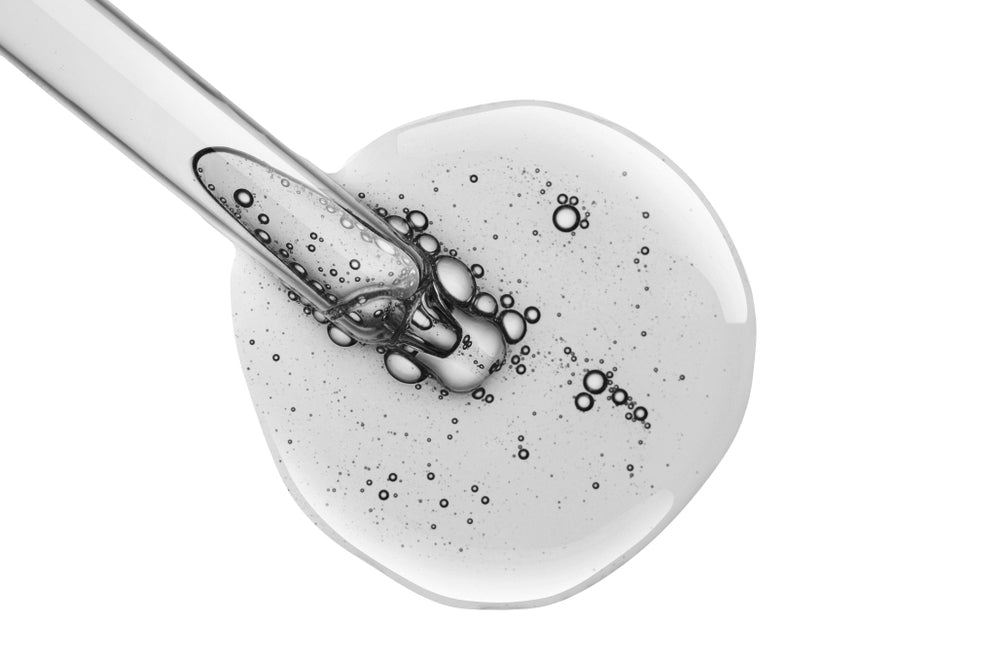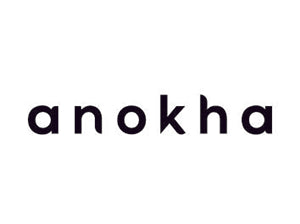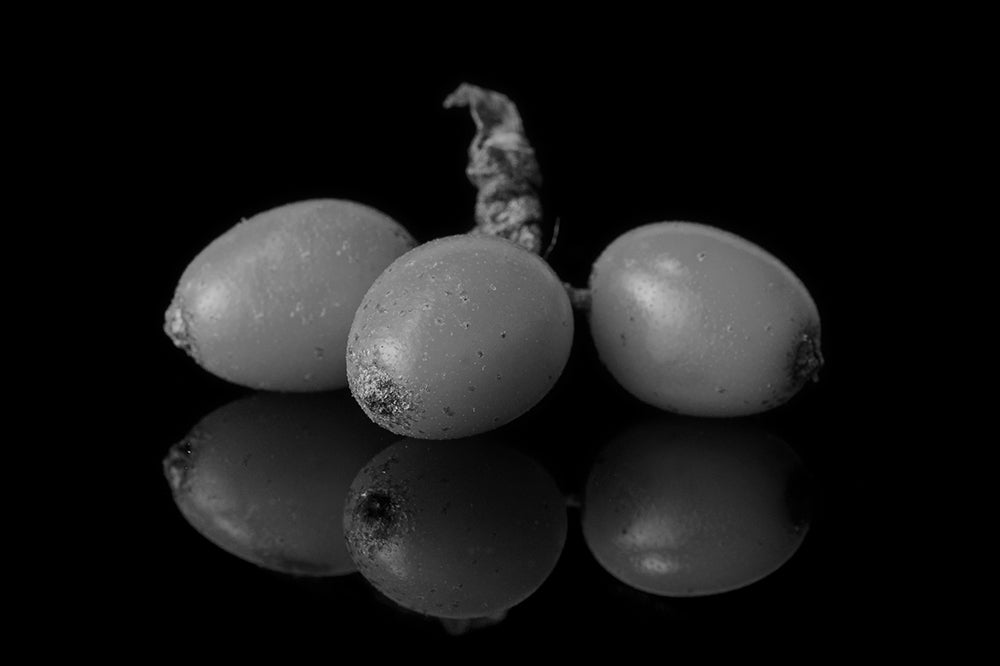
ingredient focus: hyaluronic acid

the bottom line
You may have heard or read that hyaluronic acid is a potent molecule with the ability to bind up to 1000 times its own weight in water, which renders it an incredibly effective skin humectant*. Although the average person possesses 15 g of hyaluronic acid in his or her body, approximately one-third of that amount is broken down and re-synthesized every day. As we age, the amount of hyaluronic acid in the epidermis diminishes, leading to the loss of skin moisture. A deep dive into the science and use of hyaluronic acid in both medical and non-medical skincare provides us with clues to the mystery of skin aging. Read on for more.
first layer: the history
Hyaluronic acid was first isolated in 1934 from the vitreous body of a cow’s eye by Meyer and Palmer. The first medical-grade products containing hyaluron were correspondingly used in eye surgery, including corneal transplantation and the repair of retinal detachment. Because natural hyaluronic acid has a relatively short half-life (indicating that the body breaks it down quickly), different manufacturing techniques have been used to stabilize and extend the length of the molecule chain.
Although hyaluronic acid was previously derived from rooster combs, it’s now made via biotechnological fermentation of glucose and yeast extract. Hyaluronic acid plays an important role in the human body and is involved in hydration and joint lubrication. Its synthesis increases during tissue injury and wound healing, and it regulates specific aspects of tissue repair. Hyaluronic acid has played an increasingly important role in the elucidation of how skin changes over time, and what treatments can be used to mitigate the more negative aspects of aged skin.
second layer: the science
Let’s start with the inevitable – skin aging. Skin ages through two mechanisms – intrinsic and extrinsic. Intrinsic skin aging refers to the physiologic changes that eventually occur in all of us, resulting in thinner and drier skin with fine wrinkles. Extrinsic skin aging is caused by environmental aggressors, including pollution, smoking, poor nutrition, and exposure to ultraviolet (UV) rays. These factors manifest as deeper wrinkles, loss of skin elasticity, skin laxity, and rough textured skin. Photoaging, which occurs secondary to long-term exposure to solar UV radiation, is the primary factor of extrinsic skin aging.
Skin aging, whether as a result of intrinsic or extrinsic factors, is invariably also associated with a decrease in skin moisture. The key molecule responsible for skin moisture is hyaluronan or hyaluronic acid, a naturally occurring glycosaminoglycan* which is able to bind and retain water molecules. More than 50% of hyaluronic acid is found in the dermis where it is responsible for the structure and hydration of the skin. The quantity of hyaluronic acid in the skin impressively represents one-third of the entire volume of hyaluronic acid present in the human body. As skin ages, the level of hyaluronic acid in the epidermis drops dramatically, while that in the dermis is generally retained. The size of hyaluronic acid polymers has also been noted to decrease with age. The result is dehydrated skin, atrophy, and loss of skin elasticity.
third layer: skincare
Hyaluronic acid is an incredibly popular skincare ingredient because of its versatility. The sodium salt of hyaluronic acid, sodium hyaluronate, is highly soluble in water and is typically used in skincare formulation of hyaluronic acid serums. Two types of hyaluronic acid are generally used in skincare: high molecular weight and low molecular weight. High molecular weight hyaluronic acid, which forms a gel, creates a light layer on the surface of the skin, which in turn retains water in the stratum corneum* of the epidermis and limits the effect of environmental factors such as temperature, humidity, and ultraviolet radiation. Low molecular weight hyaluronic acid has smaller molecules and penetrates deeper into the epidermis to hydrate the skin. As a result, it is noted to improve skin hydration and wrinkle depth. Low molecular weight hyaluronic acid has also been found to influence the expression of genes contributing to keratinocyte* differentiation and the formation of tight intercellular junction complexes* which are reduced in photodamaged and aged skin.
As mentioned previously, hyaluronic acid is now manufactured by the biotechnological fermentation of glucose and yeast extract. Glucose is a simple sugar that is able to bind water to the skin. It acts as both a humectant* and a skin-conditioning agent. Yeast extract, which also conditions skin, is a source of both beta-glucan and vitamin B which soothe skin while decreasing the appearance of fine lines and wrinkles. Yeast extract is also an anti-inflammatory and antioxidant which has been shown to stimulate the production of collagen in skin.
fourth layer: how we do it
Hyaluronic acid is a key ingredient in our jasmine serum. We use hyaluronic acid with a larger molecular size, which allows our serum to remain at the surface of the skin. A light and hydrating serum, it layers jasmine, sweet almond oil, and hyaluronic acid for glowy, glossy, glassy skin. It's what dewy skin dreams are made of.
xx
anokha
references:
- https://www.formulabotanica.com
- Janes D, Glavac NK, eds. Modern Cosmetics. Velenje: Sirimo dobro besedo. 2018.
- Papakonstantinou E, Roth M, Karakiulakis G. Hyaluronic acid. A key molecule in skin aging. Dermato Endocrin 2012; 4(3): 253-258.
- https://www.wikipedia.org
- Essendoubi M, Gobinet C, Reynaud R, et al. Human skin penetration of hyaluronic acid of different molecular weights as probed by Raman spectroscopy. Skin Res Tech 2016; 22: 55-62.
- Farwick M, Gauglitz G, Pavicic T, et al. Fifty-kDa hyaluronic acid upregulates some epidermal genes without changing TNF-alpha expression in reconstituted epidermis. Skin Pharmacol Physiol 2011; 24: 210-217.
- Zhang S, Duan E. Fighting against Skin Aging: The Way from Bench to Bedside. Cell Transplant. 2018; 27(5): 729-738.
*definitions:
glycosaminoglycan: glycosaminoglycans are long linear molecules consisting of repeating disaccharide (two-sugar) units. they attract water and are used as a lubricant in the body. hyaluronic acid is an example of a glycosaminoglycan.
humectant: a humectant is a substance that attracts water from the dermis and environment.
intercellular junction complexes: cell junctions, or intercellular bridges, are a class of structures that provide contact between cells or between cells and the extracellular matrix. cell junctions also enable communication between cells through specialized protein complexes called gap junctions.
keratinocytes: keratinocytes are the primary cell of the epidermis, which is the outer layer of the skin. they constitute 90% of epidermal skin cells. keratinocytes form a barrier against environmental damage and are shed every 40-56 days in human skin.
stratum corneum: the stratum corneum is the outer layer of the epidermis. it consists of a series of layers of specialized skin cells which continuously shed. the role of the stratum corneum is to protect the inner layers of the skin.
for more beauty definitions, explore the glossary.
faq's:
what are some benefits of hyaluronic acid?
hyaluronic acid is a powerful humectant, which means that it draws water to the skin. it is able to bind up to 1000X its own weight in water.
how do I choose hyaluronic acid for sensitive skin?
hyaluronic acid is a very friendly ingredient for sensitive skin, as it is present naturally in our bodies. the key is to avoid other ingredients in your skincare products which might render them more irritating for sensitive skin types, such as sulfates, which tend to dry out the skin.
what cream has hyaluronic acid?
hyaluronic acid is a highly versatile ingredient and can be found in many skin creams and serums. to check if your favorite product contains hyaluronic acid, read the ingredient label and look for sodium hyaluronate, which is the water-soluble salt of hyaluronic acid.
does hyaluronic acid serum expire?
cosmetic products, including those with hyaluronic acid, are required to list an expiration date or use by date in most countries. look for this date on the outer packaging of your product.



leave us a comment
This site is protected by hCaptcha and the hCaptcha Privacy Policy and Terms of Service apply.